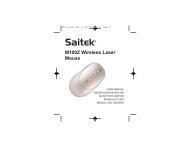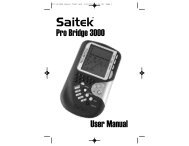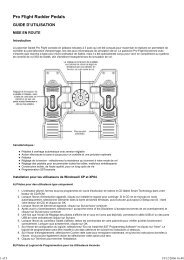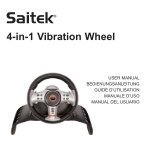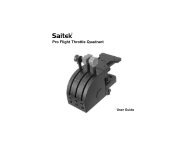Create successful ePaper yourself
Turn your PDF publications into a flip-book with our unique Google optimized e-Paper software.
E7 .......... PLY: 5E8 .......... PLY:13F7 .......... PLY: 6F8 .......... PLY:14G7 ......... PLY: 7G8 ......... PLY:15H7 .......... PLY: 8H8 .......... PLY:16On the Training Levels, the <strong>com</strong>puter’s search depth is limited to acertain number of moves, as shown above. As you cycle through thelevels, the <strong>com</strong>puter displays PLY:# for each level. A “ply” is an individualmove (a move for either side), and “#” is the number representingthe search depth. For example, on Level A7, the <strong>com</strong>puter searches toa depth of one ply (PLY:1), and thus looks ahead only one individualmove. On this level, therefore, it will often overlook a mate in one. Thisproduces weaker play, giving beginners a better chance of beating the<strong>com</strong>puter.4. INFO MODE: WATCH AND LEARNImagine this: You’re playing chess against a friend, and it’s his move.You’d love to know what move he’s thinking about, and you’d really liketo get his opinion of the board position. But, of course, you won’t ask—because that’s just not done. Well, guess what—when you play againstthis chess <strong>com</strong>puter, you can ask anything you want, and you’ll get allthe answers! In fact, you can get an incredible amount of informationabout the <strong>com</strong>puter’s thought process. On request, it will show you themove it’s thinking of, the line of play it expects after that move, itsevaluation of the current board position, how deeply it is searching, andmore. As you can imagine, studying this information can help you learnso much more about chess.Using Info ModeHow do you access all this game information? By using Info Mode atany time! If you do this while the <strong>com</strong>puter is thinking, you’ll see theinformation displays change as the <strong>com</strong>puter considers different movesand searches deeper!See “INFO MODE AT A GLANCE!” for a chart summarizing allthe Info Mode displays.Game information is divided into four groups, and pressing INFOcycles from one group to another. The BLACK/> and WHITE/< keyscan be used to cycle through the displays within each of the groups.Press CLEAR to exit Info Mode and go back to showing the normalchess clock.After learning about Info Mode, take a look at Section 5.3 for adescription of the Rotating Display feature. Selecting this feature makesthe <strong>com</strong>puter automatically cycle through the requested information inone-second intervals every time it thinks about its move—you canactually watch the <strong>com</strong>puter “think out loud”! Whenever requestedinformation is not available, the display will show dashes (– ––––).4.1 Principal VariationPress INFO the first time to get information on the principal variation(the predicted line of play, or the sequence of moves the <strong>com</strong>puterthinks will be made). The first display you will see is the move the<strong>com</strong>puter is currently thinking of making. The principal variation isshown to a maximum depth of four individual moves. Press BLACK/>repeatedly to scroll forward through all the moves:•Move 1 (predicted line of play)•Move 2 (predicted line of play)•Move 3 (predicted line of play)•Move 4 (predicted line of play)Press WHITE/< to scroll backward and see previous displays again.Press CLEAR to return to the normal clock display.Since the first move of the predicted line of play is the move the<strong>com</strong>puter assumes you will make, you can also consider this move as ahint! So—whenever you need help, press INFO on your turn.4.2 Search InformationPress INFO a second time to get information on the <strong>com</strong>puter’ssearch! Press BLACK/> repeatedly to scroll forward through thesefour displays:•Evaluation of the current position (based on a pawn being worth1.0 points; a positive number indicates White is ahead)•Two numbers: The first is the current search depth, or the numberof individual moves the <strong>com</strong>puter is looking ahead; the second isthe number of moves the <strong>com</strong>puter has examined so far• The move currently being considered• The search speed, or number of positions (nodes) being searchedevery secondPress WHITE/< to scroll backward and see previous displays again.Press CLEAR to return to the normal clock display.ENGLISH11





